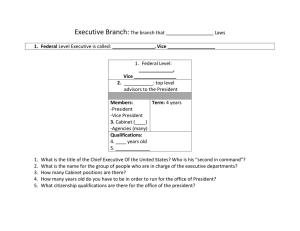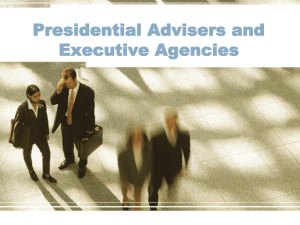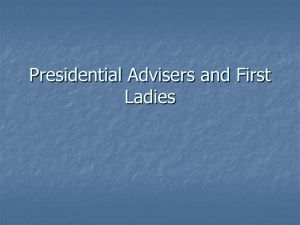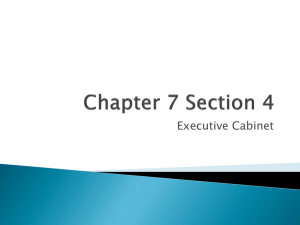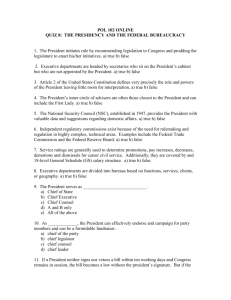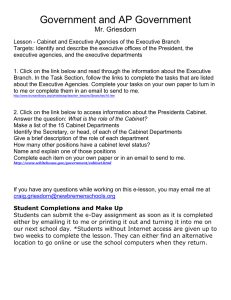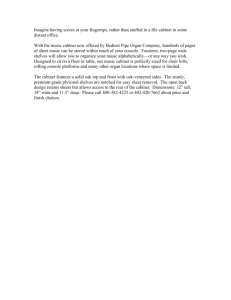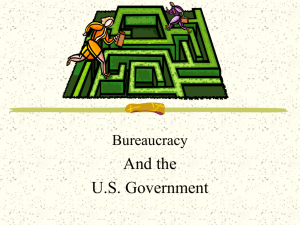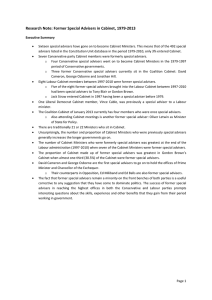Chapter 7 Section 4 Presidential Advisers and Executive Agencies
advertisement
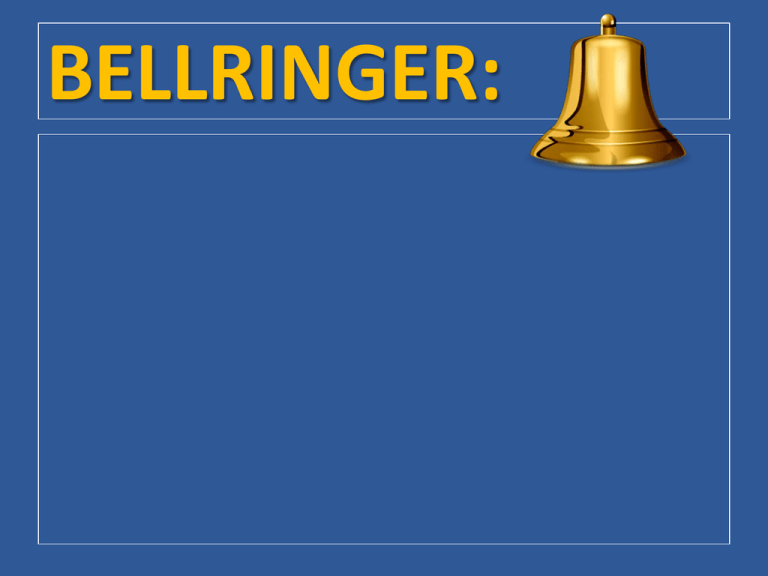
BELLRINGER: Chapter 7 / Section 4: Presidential Advisers and Executive Agencies I. Executive Office of the President • A. The employees of the Executive Office of the President (EOP) help the president by preparing reports, helping to write bills, and checking the work of various agencies. • B. The people of the White House Office work directly for the president. About 10 to 12 of these 500 people are the president’s closest advisers. They make up the White House staff. The most powerful is the chief of staff. • C. The White House Staff screens the flow of information and people to the president. As a result, this group has a lot of power. • D. The Office of Management and Budget (OMB) prepares the federal budget and monitors government spending. The federal budget lays out the administration’s plans and goals for the coming year. • E. The National Security Council helps the president coordinate the military and foreign policy. It includes the vice president, the secretaries of state and defense, and the chairman of the Joint Chiefs of Staff, a group made up of the top commander of each of the armed services. The NSC supervises the Central Intelligence Agency (CIA). • F. George W. Bush created the Office of Homeland Security to deal with terrorist activities. It includes members of the cabinet and of agencies such as the Federal Bureau of Investigation (FBI) and Border Patrol. • G. The three members of the Council of Economic Advisers advise the president about complex economic matters, such as employment, tax policy, inflation, and trade. II. Cabinet • A. The cabinet is a group of advisers that includes the heads of the 14 top-level executive departments. The head of the Department of Justice is called the attorney general. The other department heads are called secretaries. • B. Cabinet members advise the president on issues related to their departments. The president decides when the cabinet meets and how much to rely on their advice. The President’s Cabinet GROUP WORK: Discussion Question: • How did the cabinet develop? ANSWER: • No mention of the cabinet appears in the Constitution. Instead, this body developed over the years through custom and usage. It started when George Washington began meeting regularly with department heads. III. The Vice President and the First Lady • A. Most presidents have delegated little authority to their vice presidents, though this is changing somewhat. Modern vice presidents have served on special advisory boards. They often visit foreign countries as representatives of the president. • B. The Constitution does not mention the president’s spouse. Many First Ladies, though, have served the country in useful ways. Today First Ladies have an office and staff in the White House. WHAT ARE THE CURRENT FIRST LADY’S IMPORTANT PROJECTS? IV. The Federal Bureaucracy A. The executive branch is shaped like a pyramid. Directly below the president are the cabinet secretaries and their departments. At the next level are hundreds of agencies. Together, the agencies and employees of the executive branch are known as the federal bureaucracy. The workers are called bureaucrats, or civil servants. • B. These departments and agencies carry out government programs by performing three basic jobs: (1) They develop procedures for putting new laws into practice. (2) They administer day-to-day operations of the government. (3) They regulate, or police, various activities. In doing these jobs they help shape government policy. • C. Independent agencies are not part of the cabinet, but they are not independent of the president. The three types are: executive agencies, regulatory commissions, and government corporations. • D. Executive agencies deal with certain specialized areas. The National Aeronautics and Space Administration (NASA) is one example. • E. Government corporations are like private businesses, except that the government owns and runs them. Like businesses, they charge for their services, but they are not supposed to make a profit. The United States Postal Service is a government corporation. • F. Unlike other independent agencies, regulatory commissions do not report to the president. The president appoints members, but only Congress can remove them through impeachment. Regulatory commissions protect the public by making and enforcing rules for certain industries. • G. Top department jobs generally go to political appointees – people whom the president has chosen because they have ability or were supporters of the president’s election campaign. Their employment usually ends when the president leaves office. • H. About 90 percent of national government employees are civil service workers. Unlike appointees, they usually have permanent employment. The civil service system hires government workers on the basis of open, competitive examinations and merit. • I. Before 1883 government jobs went to the people as a reward for their political support. Abuses of this spoils system led Congress to pass the Pendleton Act, also known as the Civil Service Reform Act of 1883. This law limited the number of jobs the president could give to friends and backers. It also created the civil service system. • J. The Office of Personnel Management (OPM) directs the civil service system. It sets job standards and gives written tests to job seekers. The civil service system is a merit system. Government officials hire new workers from lists of people who have passed the test or otherwise met civil service standards. EXIT STRATEGY:
